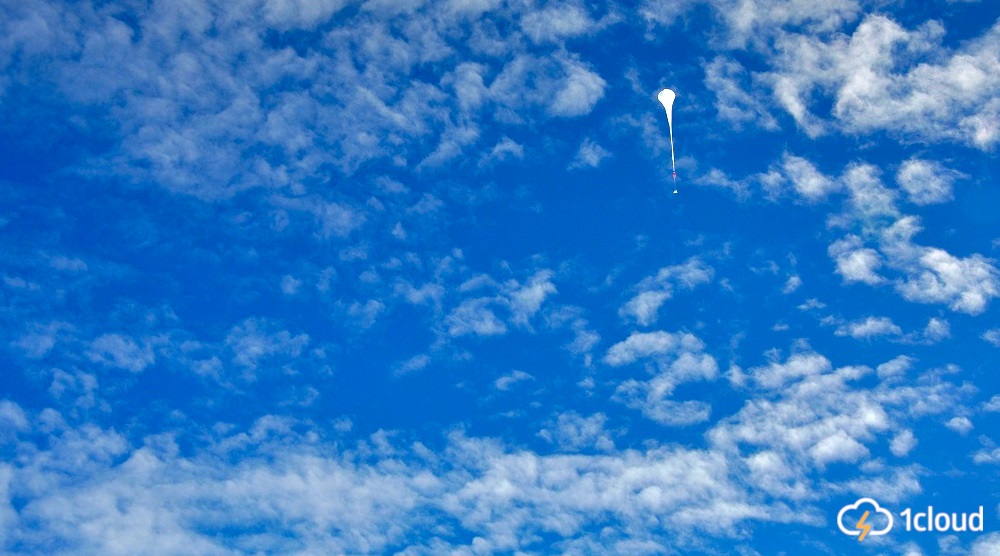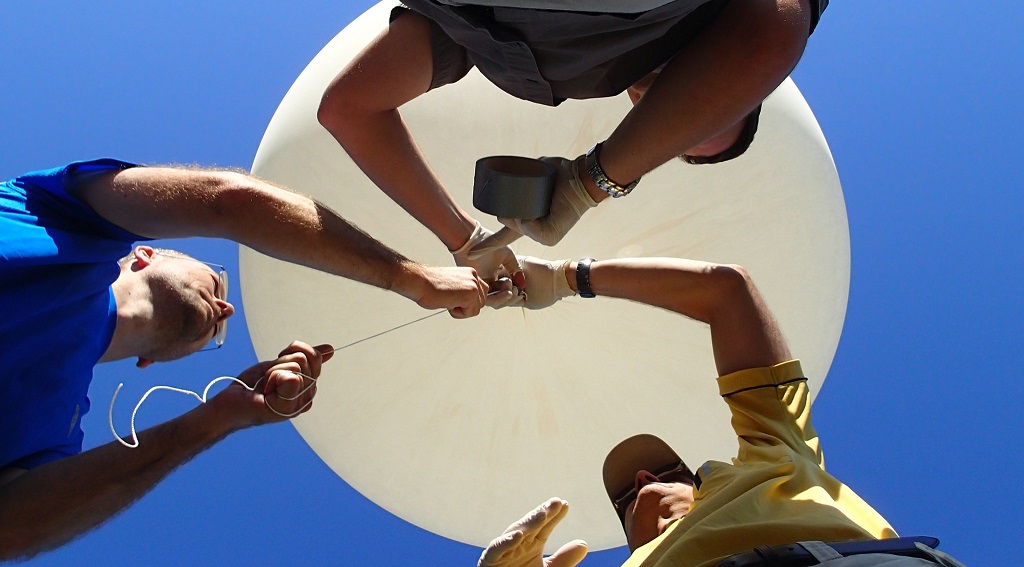766 km - a new range record for LoRaWAN
Data transmission over a record distance was carried out by engineers from Spain. They worked with the LoRaWAN protocol (for IoT), and the transfer was from a balloon to a base station in the mountains.

Photo - NASA - CC-BY / Photo modified
LoRaWAN is an open MAC protocol that is responsible for routing packets in LPWAN networks . This is a wireless technology that is used to collect data from the gadgets of the Internet of things: sensors, counters and sensors. A device with an LPWAN module transmits data over the air to the base station. The station receives signals from all smart devices within its range, digitizes and broadcasts to a remote server (for example, in the cloud) using Ethernet, VSAT or cellular communication.
Two years ago, the maximum distance to the base station to which LoRaWAN devices could transmit a packet was 702 km. In the IT industry, it was even felt that it was almost impossible to beat this record. However, in mid-July 2019 he was beaten - and twice. The new record was 766 km.
The champions were the participants of the Servet project in Spain - within its framework, citizen-scientists conduct stratospheric studies. Professional engineers and amateurs launched seven balloons, which placed twenty different LPWAN probes.
The first record was broken by a probe called PaPe I, assembled by a Spanish engineer . It had 3D Moxon rectangular antennas printed on a 3D printer. These antennas were located at an angle of 120 degrees relative to each other and connected to the ESP32, ESP8266 and ASME Lion SOM microcontrollers. The probe’s photo can be found on the link , and all drawings and diagrams can be found in the repository on GitHub . The device was able to successfully transmit the data packet to the base station in Lisbon, being at a distance of 741 km from it.

Photos - IBM Research - CC BY-NA
The second record holder was the Diana I probe, which was assembled by engineers from the University of Zaragoza. The balloon with their device rose to a height of 18 kilometers and transmitted data packets to 24 base stations. One of them was located at a ski resort 766 kilometers away . The power of the Diana I transmitter was 25 mW.
Increasing the range of data transmission via LoRaWAN will allow one base station to work with a large number of IoT devices. In turn, this will provide an opportunity to save on IT infrastructure. However, it is important to consider that engineers set a range record in “ideal conditions” (using balloons). With dense urban development, the possibilities will be different. But one of the residents of Hacker News noted that its partial closure could prevent the widespread distribution of the protocol. Although LoRaWAN is an open source solution , it works in tandem with the proprietary LoRa PHY physical layer protocol . His documentation is not publicly available.
According to analysts from the National Informatization Center, by 2022 narrow-band wireless networks will cover 75% of the major cities of our country. In particular, LoRaWAN can be used to collect telemetry information at transport infrastructure facilities.
It can be expected that the coverage of LoRaWAN networks will only expand. The line of smart devices that support working with this protocol will also begin to expand. Water, electricity, heat meters with integrated LoRaWAN modules have already become commonplace. Over time, they will begin to be introduced not only in the housing and utilities sector, but also in retail, manufacturing and other fields. The work of IoT devices will be based on a resilient cloud infrastructure . You can already find frameworks and guides for configuring cloud LoRaWAN servers on the network .
 Affiliate program 1cloud.ru . Users of our cloud can earn income and reduce the cost of renting virtual infrastructure.
Affiliate program 1cloud.ru . Users of our cloud can earn income and reduce the cost of renting virtual infrastructure.

Photo - NASA - CC-BY / Photo modified
What is this record
LoRaWAN is an open MAC protocol that is responsible for routing packets in LPWAN networks . This is a wireless technology that is used to collect data from the gadgets of the Internet of things: sensors, counters and sensors. A device with an LPWAN module transmits data over the air to the base station. The station receives signals from all smart devices within its range, digitizes and broadcasts to a remote server (for example, in the cloud) using Ethernet, VSAT or cellular communication.
Two years ago, the maximum distance to the base station to which LoRaWAN devices could transmit a packet was 702 km. In the IT industry, it was even felt that it was almost impossible to beat this record. However, in mid-July 2019 he was beaten - and twice. The new record was 766 km.
How they beat him
The champions were the participants of the Servet project in Spain - within its framework, citizen-scientists conduct stratospheric studies. Professional engineers and amateurs launched seven balloons, which placed twenty different LPWAN probes.
The first record was broken by a probe called PaPe I, assembled by a Spanish engineer . It had 3D Moxon rectangular antennas printed on a 3D printer. These antennas were located at an angle of 120 degrees relative to each other and connected to the ESP32, ESP8266 and ASME Lion SOM microcontrollers. The probe’s photo can be found on the link , and all drawings and diagrams can be found in the repository on GitHub . The device was able to successfully transmit the data packet to the base station in Lisbon, being at a distance of 741 km from it.

Photos - IBM Research - CC BY-NA
The second record holder was the Diana I probe, which was assembled by engineers from the University of Zaragoza. The balloon with their device rose to a height of 18 kilometers and transmitted data packets to 24 base stations. One of them was located at a ski resort 766 kilometers away . The power of the Diana I transmitter was 25 mW.
Prospects for LoRaWAN
Increasing the range of data transmission via LoRaWAN will allow one base station to work with a large number of IoT devices. In turn, this will provide an opportunity to save on IT infrastructure. However, it is important to consider that engineers set a range record in “ideal conditions” (using balloons). With dense urban development, the possibilities will be different. But one of the residents of Hacker News noted that its partial closure could prevent the widespread distribution of the protocol. Although LoRaWAN is an open source solution , it works in tandem with the proprietary LoRa PHY physical layer protocol . His documentation is not publicly available.
Despite this fact, LoRaWAN is considered one of the most promising protocols for deploying the Internet of things infrastructure. In 2015, the entire Amsterdam network was covered by the LoRaWAN network. Similar systems are being deployed in 80 countries, including Russia.
According to analysts from the National Informatization Center, by 2022 narrow-band wireless networks will cover 75% of the major cities of our country. In particular, LoRaWAN can be used to collect telemetry information at transport infrastructure facilities.
It can be expected that the coverage of LoRaWAN networks will only expand. The line of smart devices that support working with this protocol will also begin to expand. Water, electricity, heat meters with integrated LoRaWAN modules have already become commonplace. Over time, they will begin to be introduced not only in the housing and utilities sector, but also in retail, manufacturing and other fields. The work of IoT devices will be based on a resilient cloud infrastructure . You can already find frameworks and guides for configuring cloud LoRaWAN servers on the network .
What we write about in our blogs and social networks:
"Hide www": why mainstream browser developers again refused to display the subdomain
"Mat. Wall Street model ”or an attempt to optimize the cost of cloud IT infrastructure
DevOps in a cloud service using 1cloud.ru as an example
Big Data: Big Opportunity or Big Deception
How cloud technology has helped to make out a black hole
How does 1cloud tech support work
 Affiliate program 1cloud.ru . Users of our cloud can earn income and reduce the cost of renting virtual infrastructure.
Affiliate program 1cloud.ru . Users of our cloud can earn income and reduce the cost of renting virtual infrastructure.
All Articles